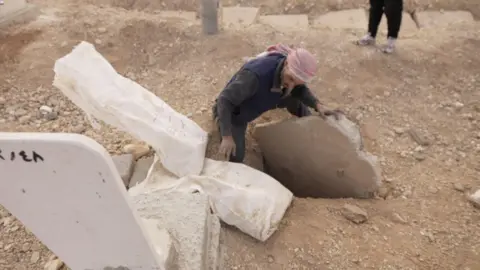 BBC
BBCAdra is a strange kind of neighbourhood cemetery – two lone graves sit in an empty expanse of bumpy earth, sparsely covered with grass.
For years, this was an area tightly controlled by President Bashar al-Assad’s forces.
Now, a week after they fled, a concrete slab in one corner of this empty cemetery has been moved to reveal a shallow grave containing at least half a dozen white bags, labelled with names and prison numbers.
Khaled al Hamad, a nearby resident, was desperately pulling the bags out when we arrived.
He shows us the three he has already opened. Each contains a human skull and bones. The writing on the sacks suggest they are the remains of two female prisoners, and one male.
It is not clear how they died, or whether this is evidence of criminal abuse by Assad’s regime.
But Khaled needs no convincing. He’s searching for his two brothers, Jihad and Hussein, taken by Assad’s notorious air force intelligence a decade ago. They haven’t been heard of since.
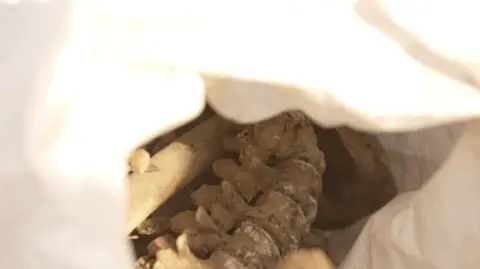
“Some people were taken to an area called ‘the driving school’ and liquidated there,” he said. “I expect this happened to my brothers. Maybe they are in some of these bags buried here.”
We shared this information with Human Rights Watch in Syria, who said they were investigating reports of prisoners’ remains dumped in similar bags elsewhere.
Assad’s fall has unleashed a tsunami of hope from families who were left for decades without any way of finding out what happened to their loved ones.
“If you ever came past here [in Assad’s time], you couldn’t stop, you couldn’t look up,” Khaled said.
“Cars used to speed past. If you stopped, they would come to you, put a plastic bag on your head and take you away.”
Tens of thousands of families like his are now searching for relatives who disappeared into Assad’s notorious prison system, or into its military interrogation centres.
Some were taken to the Mazzeh military airbase in Damascus.
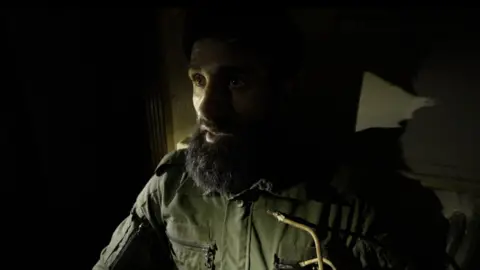
This site, once a key buffer between Assad and rebel forces, is deserted. Discarded military boots are strewn on the runway, a live rocket lies on the ground, the only signs of life are the new guards at the gate: young militia men from Hayat Tahrir al-Sham (HTS), the group that took control of Syria last week.
They show us the torture room used by Assad’s forces – including a metal pole to secure prisoners’ feet for beating, and a set of wires next to an electrical switchboard.
“Here they electrocuted prisoners,” the guards’ commander, Abu Jarrah, tells me. “These are electric cables – the investigator sits here, the guards put them on the prisoner’s body and turn on the power.
“The prisoner loses his mind and confesses everything. They tell the interrogator to write whatever he wants, in the hope it will stop.”
Abu Jarrah also said that the 400 women held here were routinely raped, and that children were born into the prison.
The only thing more painful than finding your parent or child among the records here is not finding them at all.
In the building next door, families scratch desperately through thumbnail photos scattered in piles on the concrete floor – face after face staring grim and blank, silent witnesses to the years of Assad’s rule.

Sobbing among them was the mother of Mahmoud Saed Hussein, a Kurd from al-Qamishli.
“Yesterday, we saw he was registered at the airbase prison,” she told me. “We came but couldn’t find him. I’ve been looking for him for 11 years, searching from one prison to another.”
“These are all like my son,” she wept, gesturing at the piles of photos on the floor. “May God burn Assad’s heart, as he has burned ours.”
Beyond them, three rooms packed to the rafters with files open out on each other, one after the other. Several people are crouching on a mountain of documents several feet high covering the floor.
Assad’s regime was meticulous in documenting its brutality – a vast bureaucracy of terror that makes the scale of its actions all too clear, but in which the stories of individuals are often lost or submerged.
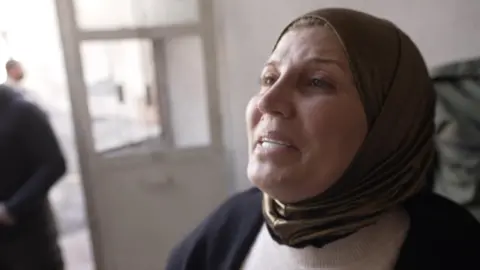
“What are these notes?” one woman raged. “Nobody is helping us. We want someone to come and check these documents with us. How can I find him among this many prison files?”
The lack of any ordered system means critical evidence is being lost each day at sites across Syria – information about the missing, but also potentially, any links between Assad’s regime and foreign governments like the US or the UK, both of which have been accused of benefitting from the American policy of extraordinary rendition, in which terrorist suspects were sent for interrogation to countries that used torture.
Human rights groups have accused the UK government of turning a blind eye to the US practice during the so-called war on terror, when America sent detainees to several countries in the Middle East, including Syria.
Outside, the silent hangars of the airbase are dotted with the charred remains of Russian-made planes and radar, hit by repeated Israeli airstrikes over the past week.
Assad’s departure has shifted the delicate balance of power between conflicting groups in Syria, and their various international backers, including Turkey, Iran and the US.
This was never just Syria’s war and outside powers still have a stake in what happens here.
Syrians are adamant that the time has come for them to govern themselves without anyone dictating what they should do.
As we leave, a young HTS fighter climbs up on a roof to slash at the portrait of Assad hanging above the interrogation building.
He grins down to the comrades watching from below, as photos and documents from the regime’s military files flutter around their boots.
Assad’s fall has posed as-yet-unanswered questions about Syria’s future, but it has also left unanswered many questions from the past.
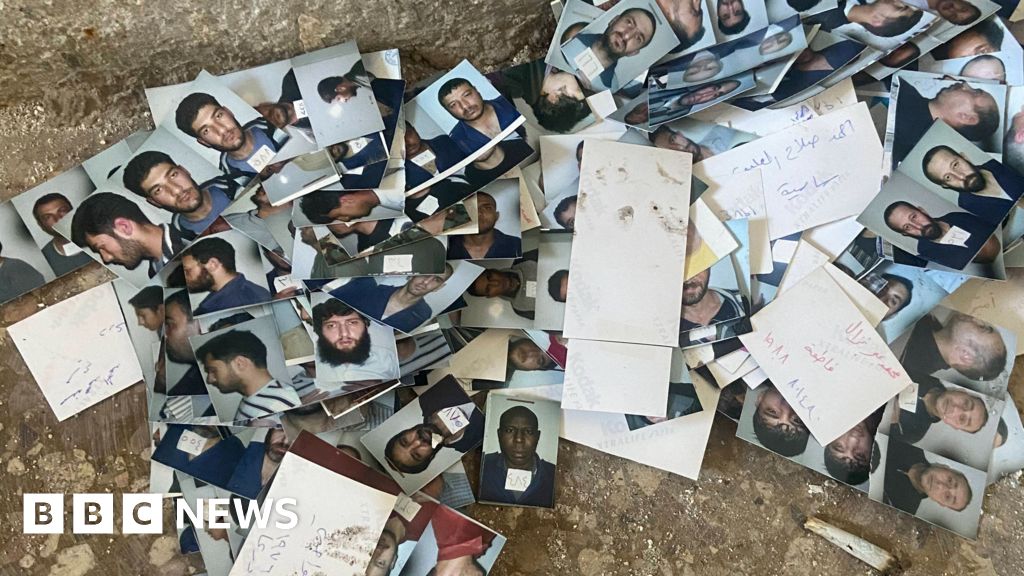

Leave a Reply